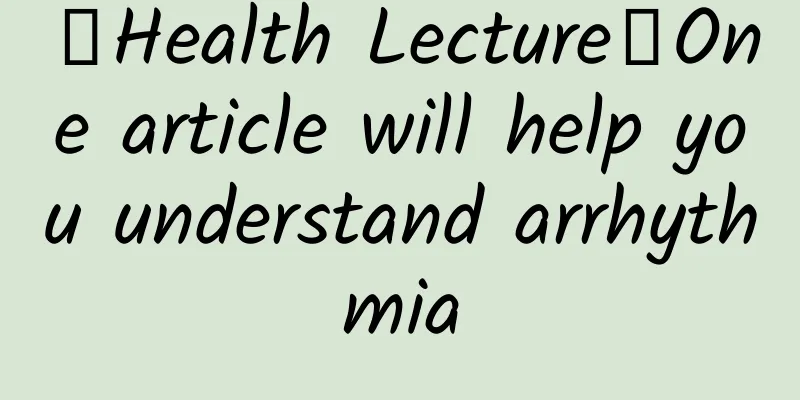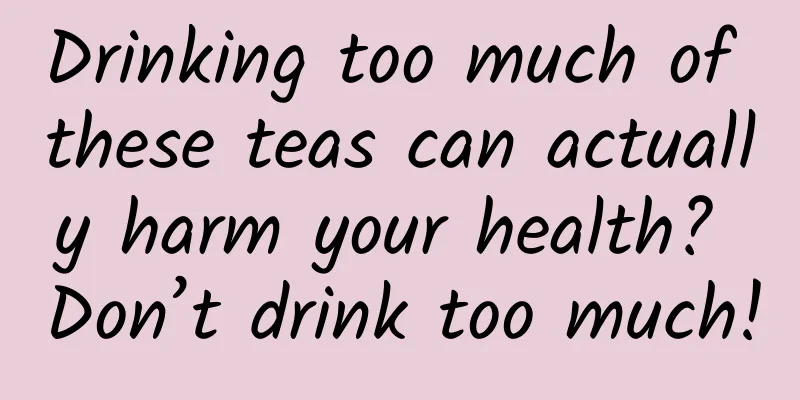【Health Lecture】One article will help you understand arrhythmia

|
In order to ensure the scientific effect of learning health knowledge in the "2024 China Elderly Health Knowledge Competition", the organizer has collected various health science articles suitable for the elderly from various hospitals, and we will share them through the "Health Lecture Hall" column. Today, Mr. Yu Haitao, the attending physician of the Department of Cardiology at Beijing Boai Hospital of the China Rehabilitation Research Center, brought us: "One article to help you understand arrhythmia", welcome elderly friends to learn. I believe everyone has had the feeling of "heart palpitations" in daily life. Sometimes when we are emotionally excited, sometimes after a lot of exercise, we often feel that our heart beats faster and stronger than usual. Some friends may feel that their hearts suddenly beat a few times for no reason in daily life. If you consult a doctor, the doctor will tell you that you may have "arrhythmia". Many friends do not understand what arrhythmia is. This disease is actually very common. According to my country's 2023 Cardiovascular Disease Report, there were 8.32 million hospitalized patients with arrhythmia in 2022. If we recall carefully, most people have experienced the symptoms of arrhythmia. So what is arrhythmia? Let's learn about it from a medical perspective today. Common manifestations of arrhythmia Our ancestors recorded the symptoms and signs of arrhythmia very early. In the classic Chinese medicine book "Huangdi Neijing", the symptoms of arrhythmia are described as "the chest and ribs are full and the heart beats violently". The ancients used the easy-to-understand phrase "the heart beats violently" to describe the most common feeling of arrhythmia patients - the violent beating of the heart. Later medical books often use "palpitations" to describe the symptoms of abnormal heart beats felt by arrhythmia patients. This term to describe the symptoms of arrhythmia is still used today. Many modern medical books use palpitations or panic to describe the feeling of abnormal heart beats when patients have arrhythmia. Due to the important position of pulse diagnosis in traditional Chinese medicine, the ancients discovered that patients with arrhythmia would have abnormal pulses very early. The Yellow Emperor's Classic of Internal Medicine records the abnormal pulses of patients with arrhythmia and some serious consequences that may be caused - "When a person exhales, his pulse beats, and when he inhales, his pulse beats, which is called lack of energy... If the pulse is not present at all, it means death; if the pulse is sometimes sparse and sometimes rapid, it means death." This passage describes the pulse manifestations of various slow and fast arrhythmias, and reflects the lack of effective means for the treatment of arrhythmias in ancient times. Ancient doctors found that the pulse of patients was extremely slow or sometimes fast and sometimes slow, so they used "the pulse is not present at all, sometimes sparse and sometimes rapid" to describe the pulse manifestations of arrhythmia in medical books, and used words such as "it means death" to record the serious consequences of arrhythmia. Through the descriptions of the sages, you have a basic understanding of the common symptoms and signs of arrhythmia - palpitations and irregular pulses. Of course, severe arrhythmia can also cause dizziness, shortness of breath, black eyes, syncope and other symptoms. What is Arrhythmia Modern medicine has conducted more detailed and thorough research on arrhythmias, and has more treatment options. Modern medicine believes that the normal beating of our heart is controlled by the sinoatrial node located in the upper right part of the heart. In a quiet state, the sinoatrial node generally regulates the heartbeat at a frequency of 60 to 100 beats per minute. This heartbeat rhythm is medically called "sinus rhythm." So sinus rhythm is our normal heart rhythm in a quiet state. When we exercise or get emotional, the sinoatrial node will regulate the heartbeat at a frequency higher than 100 beats per minute to meet our body's higher metabolic needs during exercise or emotional excitement. This is the most common arrhythmia we experience - "sinus tachycardia." Of course, we don't need to be nervous at this time, because sinus tachycardia caused by exercise or emotional factors is a normal reaction of the human body. But sometimes the function of the sinoatrial node fails, or the beating of the heart is controlled by cells in other parts of the heart other than the sinoatrial node. So in short, arrhythmia means that the beating of the heart is no longer controlled by the sinoatrial node, or the sinoatrial node itself has an abnormality in regulating the heart rhythm. Modern medicine has a variety of classifications of arrhythmias and has given them different names. For example, the "premature beats" we often hear are one type of arrhythmia, and the medical term is "premature contraction". The figure below shows the most common types of arrhythmias in hospitalized patients in my country in 2022. Types and composition of arrhythmias among hospitalized patients in China in 2022 Schematic diagram of the sinus node and conduction system Common causes of arrhythmias So what are the causes of arrhythmia? In fact, through the example of sinus tachycardia mentioned above, we can know that normal people can have arrhythmia. In addition to exercise and emotional excitement, some habits in our daily life can also cause arrhythmia, such as overwork, staying up late, long-term drinking, smoking, snoring during sleep, etc. The arrhythmias caused by these bad living habits are generally "premature beats", and most of the cases can be effectively alleviated by improving the lifestyle. Of course, arrhythmias are more likely to occur in patients who already have heart disease, such as coronary heart disease, cardiomyopathy, valvular heart disease, etc. Diseases of other systems besides the heart can also cause arrhythmias, such as hyperthyroidism, pheochromocytoma, anemia, etc. What doctors can do for arrhythmias When we go to the doctor for arrhythmia, what kind of diagnosis and treatment will the doctor give us? First of all, electrocardiogram and dynamic electrocardiogram are the most common and effective examination methods for diagnosing arrhythmia. If you are experiencing discomfort when you visit the doctor, the electrocardiogram can capture clues of arrhythmia in most cases, thereby helping the doctor make a correct diagnosis. If the discomfort symptoms have been relieved when you visit the doctor, the doctor will recommend that you do a dynamic electrocardiogram (commonly known as holter) to capture evidence of arrhythmia. In addition, transesophageal electrophysiological examination and intracardiac electrophysiological examination are more advanced and effective examination methods, which can not only make a more accurate diagnosis of arrhythmia, but also have a certain therapeutic effect, but these are all invasive examination methods and generally require hospitalization to complete. Schematic diagram of electrocardiogram and dynamic electrocardiogram examination In terms of treatment, we are no longer helpless like the ancients. In addition to various drugs, doctors can now use catheter ablation, pacemaker implantation and other surgeries to achieve a radical cure for certain arrhythmias. Schematic diagram of catheter ablation for atrial fibrillation What can we do when facing arrhythmia? First, we need to improve our lifestyle and avoid bad habits that may cause arrhythmia, such as quitting smoking, drinking, keeping a regular schedule, and avoiding excessive intake of coffee and strong tea. Secondly, learning to measure the pulse is also a practical life trick. Learn to touch the pulse of the artery at your wrist like a Chinese medicine doctor. If the pulse is irregular, it reminds us that we need to go to the hospital for treatment. In addition, modern technology has also given us more means to monitor arrhythmias. For example, most smart watches can now monitor heart rate, and some can analyze and diagnose arrhythmias through artificial intelligence, and remind the wearer to seek medical treatment in time. A foreign study in 2022 analyzed the diagnostic efficacy of 5 smart watches for atrial fibrillation. The study showed that smart watches have improved the convenience and feasibility of daily screening for arrhythmias and have good application prospects. The most important thing is that we don’t have to be as afraid of arrhythmias as the ancients. As long as we believe in medicine, follow the doctor’s advice and receive regular treatment, most arrhythmias can be effectively controlled. References: "China Cardiovascular Disease Report 2023" Huangdi Neijing Knight's Color Atlas of Cardiology, People's Medical Publishing House, 2007.12 DM Mannhart et al, Clinical Validation of 5 Direct-to-Consumer Wearable Smart Devices to Detect Atrial Fibrillation, JACC Clin Electrophysiol About the Author Yu Haitao, a master of Peking University School of Medicine, is an attending physician in the Department of Cardiology at Beijing Boai Hospital, China Rehabilitation Research Center. He completed specialized training in cardiac pacing and electrophysiology at Beijing Fuwai Cardiovascular Hospital, Chinese Academy of Medical Sciences. He is an expert in catheter ablation of arrhythmias and physiological pacing therapy. |
<<: Manyi•Issue 209 | Don’t panic if you sprain your ankle, come and see the tips!
Recommend
Pregnancy retching without vomiting means boy
There are many names for the question of whether ...
Abdominal pain after ectopic pregnancy surgery
After the ectopic pregnancy surgery, if the abdom...
Vulva redness without itching
Some people will find that their vulva looks a li...
What are the causes of female sleepiness?
With the development of society, we can see that ...
What are the dangers of women sleeping late?
Everyone needs to sleep, and developing good livi...
After reading this, do you still dare to eat instant noodles?
Instant noodles are what we often call instant no...
How to create a new Chinese style living room decoration What are the requirements for the new Chinese style living room
We all know that there are many styles of decorat...
What should women eat to promote blood circulation and remove blood stasis?
Nowadays, the status of women in society is const...
What are the specific nutrients of passion fruit? How to preserve passion fruit
Passion fruit is rich in natural vitamin C and is...
Why does the paint peel when applied with latex paint? How to apply latex paint
Latex paint has rich and varied colors, good envi...
What should you pay attention to when having sex for the first time
If a girl grows into a woman after her first expe...
What should women eat to treat uterine cold?
Many women in life suffer from irregular menstrua...
What is the normal basal metabolism of girls?
The human body metabolizes every day, and the bas...
How to lose weight for a 30-year-old woman
As we age, our bodies will undergo many changes, ...
Jeep Disease: A disease that jeeps get? No, it’s humans who get it…
There is a strange disease that causes redness, s...









